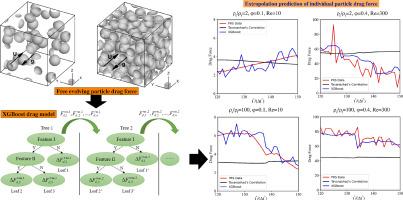为自由演变的颗粒悬浮液开发基于 XGBoost 的阻力模型
IF 4.5
2区 工程技术
Q2 ENGINEERING, CHEMICAL
引用次数: 0
摘要
利用自由演变球形粒子悬浮液的粒子解析模拟(PRS)数据,开发了基于 XGBoost 的阻力模型,包括 10 到 300 的雷诺数、0.1 到 0.4 的固体体积分数以及 2、10 和 100 的粒子与流体密度比。PRS 中 150 个连续时间实例的阻力数据分为两组:第一组包括最初 120 个实例的数据,用于模型训练和内插测试;第二组包括最后 30 个实例的阻力数据,专门用于外推测试。与传统的阻力相关性相比,内插法和外推法测试的准确性都有显著提高。值得注意的是,该模型对密度比为 100 的颗粒的预测精度最高,这是因为在密度比较低时,非稳定阻力的影响增大,而仅靠颗粒的瞬时分布是无法完全捕捉到这种影响的。本文章由计算机程序翻译,如有差异,请以英文原文为准。

Development of a XGBoost-based drag force model for freely evolving particle suspensions
An XGBoost-based drag model is developed using data from Particle Resolved Simulations (PRS) of freely evolving spherical particle suspensions, encompassing Reynolds numbers from 10 to 300, solid volume fraction between 0.1 and 0.4, and particle-to-fluid density ratio of 2, 10 and 100. Drag force data from 150 continuous time instances in PRS are divided into two sets: the first set that includes data from the initial 120 instances is used for training the model and interpolation testing, while the second set comprises drag forces from the final 30 instances is used exclusively for extrapolation testing. Both interpolation and extrapolation tests demonstrate significantly improved accuracy compared to traditional drag correlations. Notably, the model achieves its highest prediction accuracy for particles with density ratios of 100, which is attributed to the increased influence of unsteady drag forces at lower density ratios that cannot be fully captured by instantaneous particle distributions alone.
求助全文
通过发布文献求助,成功后即可免费获取论文全文。
去求助
来源期刊

Powder Technology
工程技术-工程:化工
CiteScore
9.90
自引率
15.40%
发文量
1047
审稿时长
46 days
期刊介绍:
Powder Technology is an International Journal on the Science and Technology of Wet and Dry Particulate Systems. Powder Technology publishes papers on all aspects of the formation of particles and their characterisation and on the study of systems containing particulate solids. No limitation is imposed on the size of the particles, which may range from nanometre scale, as in pigments or aerosols, to that of mined or quarried materials. The following list of topics is not intended to be comprehensive, but rather to indicate typical subjects which fall within the scope of the journal's interests:
Formation and synthesis of particles by precipitation and other methods.
Modification of particles by agglomeration, coating, comminution and attrition.
Characterisation of the size, shape, surface area, pore structure and strength of particles and agglomerates (including the origins and effects of inter particle forces).
Packing, failure, flow and permeability of assemblies of particles.
Particle-particle interactions and suspension rheology.
Handling and processing operations such as slurry flow, fluidization, pneumatic conveying.
Interactions between particles and their environment, including delivery of particulate products to the body.
Applications of particle technology in production of pharmaceuticals, chemicals, foods, pigments, structural, and functional materials and in environmental and energy related matters.
For materials-oriented contributions we are looking for articles revealing the effect of particle/powder characteristics (size, morphology and composition, in that order) on material performance or functionality and, ideally, comparison to any industrial standard.
 求助内容:
求助内容: 应助结果提醒方式:
应助结果提醒方式:


